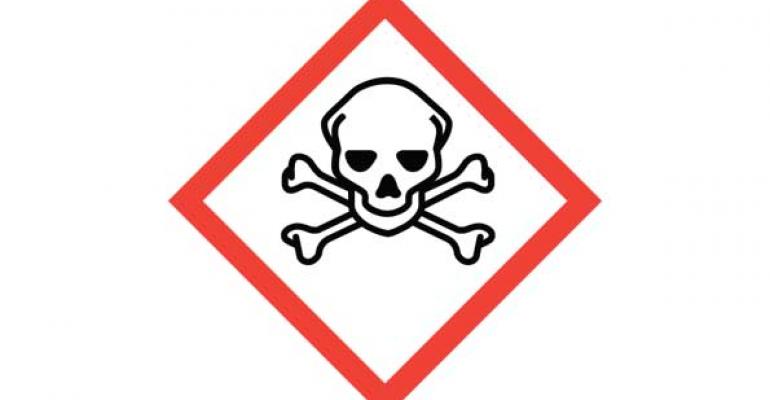Restaurant owners face a fast-approaching regulatory deadline, yet many may not be aware of it or know what they need to do to comply.
By Dec. 1, 2013, all U.S. employers whose workers may come in contact with chemicals must provide training to help them understand new hazard symbols and warnings that are beginning to appear on product labels and safety data sheets. Those symbols and warnings will become standard over the next several years.
The new hazard communications are a modification to the current Hazard Communications Standard (HCS), administered by U.S. Occupational Safety and Health Administration (OSHA). Referred to as GHS, which stands for the Globally Harmonized System of Classification and Labeling of Chemicals, the modification is based on an effort to standardize hazard communication worldwide initiated by the United Nations in 1992 and developed over the ensuing decades.
Now being implemented by the U.S. and many other nations, GHS aims to “harmonize” the ways in which chemical hazards are classified and communicated globally. Improved worker safety is the primary goal.
The first of two deadlines: Staff training
Restaurant owners face two regulatory deadlines during GHS implementation. The first is Dec. 1, 2013; the second is June 1, 2016. Both will be enforced by OSHA’s state-level inspectors.
You need take only one step to meet the December deadline: Train your employees to recognize and understand new GHS pictograms, signal words and precautionary statements that will appear on product labels, and familiarize them with the new GHS safety data sheet format.
To be clear, you may continue to use products labeled under the existing hazard communication system after Dec. 1. In fact, you may continue to use them until the second deadline for restaurant owners: June 1, 2016, the date OSHA says all chemicals in your inventory must be GHS compliant.
Between Dec. 1 of this year and June 2016, you may use products labeled under both the current and new systems. Regardless of a product’s label, however, you must have its matching safety data sheet. Not having it could result in a violation and fine.
Training employees now is critical to prepare them to properly handle GHS-classified and labeled products from the minute they arrive. If you have not yet received GHS-labeled products, it’s likely you soon will. Manufacturers are beginning to phase in the label and safety data sheet (no longer referred to as the “material safety data sheet”) changes to meet their June 1, 2015, deadline for full compliance.
What will change?
(Continued from page 1)
Under GHS, manufacturers must use specific criteria to evaluate the severity of the health and physical hazards their products pose. Based on the assessment, they are to assign them a hazard classification. The classification, in turn, governs the information they must include on the product label and safety data sheet, and ultimately how the product must be handled.
Currently, manufacturers must identify the chemical and appropriate hazard warnings on product labels. Going forward, they are required to include hazard information on labels and safety data sheets using four integrated communication elements:
• A pictogram, a symbol displayed on a white background inside a red, diamond-shaped border that is designed to convey—without language—the type of hazard.
• A signal word, a one-word alert indicating hazard severity. Under the modified hazard communication system, “danger” will describe more severe hazards and “warning” will indicate those that are less severe. No signal word indicates a relatively low hazard.
• A hazard statement, a description of the nature of the hazard and, when appropriate, its severity.
• Precautionary statement, a description of what to do to prevent or minimize the hazard.
In addition, the format of the safety data sheet will be standardized, a change intended to make finding hazard, first aid and personal protective equipment (PPE) information easier.
Finally, one other change is likely to result from the conversion to GHS, though not immediately. The price of chemicals may eventually increase as there are significant costs associated with the development and manufacturing systems to comply with this regulatory change.
Complying by Dec. 1, 2013
You probably don’t need to be reminded that the Dec. 1 training deadline is just weeks away. As a restaurant owner, you may rely on training tools developed by suppliers or others, but OSHA will hold you responsible for making sure all employees, including temporary and contract workers, who may come into contact with chemicals understand the new system and that their training is documented.
Resources are available to help you prepare for training and the transition to GHS-labeled products. Check with your chemical suppliers: They may want to help you meet your compliance deadlines. For example, they may have prepared materials and tools designed to help you train employees.
Also visit the OSHA website https://www.osha.gov/dsg/hazcom/index.html to download the fact sheet, “December 1st, 2013, Training Requirements for the Revised Hazard Communication Standard,” for more details about the new hazard communication system and what you need to do to comply.
Training your employees before the Dec. 1 deadline will be well worth the effort. Knowing that you have taken steps to help employees stay healthy and safe—and to protect your business from OSHA violations and fines—will provide ample payoff.
Steve Christenson is global regulatory affairs v.p. and associate general counsel for Ecolab Inc., responsible for managing the company’s product registration, chemical substance clearance, product safety, transportation and trade compliance programs. He is also directing a multi-million-dollar IT initiative to standardize Ecolab’s chemical safety hazard communication to customers in the U.S., Canada and more than 50 countries around the world.





